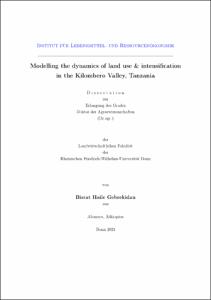Gebrekidan, Bisrat Haile: Modelling the dynamics of land use & intensification in the Kilombero Valley, Tanzania. - Bonn, 2021. - Dissertation, Rheinische Friedrich-Wilhelms-Universität Bonn.
Online-Ausgabe in bonndoc: https://nbn-resolving.org/urn:nbn:de:hbz:5-62473
Online-Ausgabe in bonndoc: https://nbn-resolving.org/urn:nbn:de:hbz:5-62473
@phdthesis{handle:20.500.11811/9171,
urn: https://nbn-resolving.org/urn:nbn:de:hbz:5-62473,
author = {{Bisrat Haile Gebrekidan}},
title = {Modelling the dynamics of land use & intensification in the Kilombero Valley, Tanzania},
school = {Rheinische Friedrich-Wilhelms-Universität Bonn},
year = 2021,
month = jun,
note = {This thesis intends to examine the determinants and results of farmer’s decisions to uptake different paths of intensification, land use, and its dynamics over time by building a spatially and temporally explicit agent-based model in the Kilombero Valley Floodplain (KVF) in Tanzania. The thesis is structured into an introduction and four main chapters, each answering a specific research question.
First, the introduction motivates the study and states the research questions. A brief context of the study site (KVF) and the different data sources and collection methods is given. Then, the four main chapters are summarized regarding the specific objectives, the approach and the main results as well as the contributions to the literature. It concluded with general limitations and outlook.
The second chapter provides a systematic review of agent-based models of land use in agricultural systems. Guided by the MRPOTATOHEAD framework, the review identifies the modeling components that appear in all the models and, how they are represented. Moreover, their peculiarities in the specific model or case study are discussed. The results show that models are unique in terms of scale, level of detail in both human and biophysical dimensions and the employed decision-making routines. Also, models are tailored to a particular study area and farming system under consideration.The targeted design of the models for specific study-regions and agricultural land uses restrict the derivation of generalizing conclusions.
The third chapter focuses on the characterization of farmers’ heterogeneity in KVF and elicits the diversity of their land use and livelihood strategies through an attribute- based typology. The approach applied to achieve this objective is a combination of principal component analysis, hierarchical clustering, and K-means clustering. Three farm types were identified: "Monocrop rice producer", "Diversifier", and "Agropastoralist". The chapter’s contributions comprise the following: (1) it offers the first concise classification of farm households in KVF (2) highlights current agricultural practices and provides vital information needed for targeted interventions per farm type (3) uses a quantitatively more rigorous and robust way to construct and validate typologies. The resulting farm types can be used in further research as a basis for building prototype farms and to parametrize agent-based models.
The fourth chapter investigates farmers’ choices of intensification strategies alongside interdependent determinants by focusing on four options (use of improved seed, fertilizer application, small-scale irrigation and increasing frequency of planting) practiced in the valley. The chapter proposes a new modeling approach to identify option-specific determinants and their interdependence by combining a Bayesian Belief Network (BBN), design of experiments, and multivariate regression trees. The method has provided us with strategy-specific factors. Although the choice of each option is affected differently by covariates under consideration, access to non-farm income, access to market, and topography of the plot play essential roles across intensification options.
The fifth and final chapter takes a broad-based approach by developing a spa- tially and temporally explicit empirical agent-based model and simulates the potential effects of in-migration and infrastructure development in the KVF. This chapter builds upon the first three chapters. Simulation results show that intensification is limited in the long run and farmers engage in land expansion rather than intensification with uncontrolled immigration into the valley. More so, access to better road infrastructure and corresponding reduction in transport cost shows a negligible effects on trends of intensification and crop production in the valley.},
url = {https://hdl.handle.net/20.500.11811/9171}
}
urn: https://nbn-resolving.org/urn:nbn:de:hbz:5-62473,
author = {{Bisrat Haile Gebrekidan}},
title = {Modelling the dynamics of land use & intensification in the Kilombero Valley, Tanzania},
school = {Rheinische Friedrich-Wilhelms-Universität Bonn},
year = 2021,
month = jun,
note = {This thesis intends to examine the determinants and results of farmer’s decisions to uptake different paths of intensification, land use, and its dynamics over time by building a spatially and temporally explicit agent-based model in the Kilombero Valley Floodplain (KVF) in Tanzania. The thesis is structured into an introduction and four main chapters, each answering a specific research question.
First, the introduction motivates the study and states the research questions. A brief context of the study site (KVF) and the different data sources and collection methods is given. Then, the four main chapters are summarized regarding the specific objectives, the approach and the main results as well as the contributions to the literature. It concluded with general limitations and outlook.
The second chapter provides a systematic review of agent-based models of land use in agricultural systems. Guided by the MRPOTATOHEAD framework, the review identifies the modeling components that appear in all the models and, how they are represented. Moreover, their peculiarities in the specific model or case study are discussed. The results show that models are unique in terms of scale, level of detail in both human and biophysical dimensions and the employed decision-making routines. Also, models are tailored to a particular study area and farming system under consideration.The targeted design of the models for specific study-regions and agricultural land uses restrict the derivation of generalizing conclusions.
The third chapter focuses on the characterization of farmers’ heterogeneity in KVF and elicits the diversity of their land use and livelihood strategies through an attribute- based typology. The approach applied to achieve this objective is a combination of principal component analysis, hierarchical clustering, and K-means clustering. Three farm types were identified: "Monocrop rice producer", "Diversifier", and "Agropastoralist". The chapter’s contributions comprise the following: (1) it offers the first concise classification of farm households in KVF (2) highlights current agricultural practices and provides vital information needed for targeted interventions per farm type (3) uses a quantitatively more rigorous and robust way to construct and validate typologies. The resulting farm types can be used in further research as a basis for building prototype farms and to parametrize agent-based models.
The fourth chapter investigates farmers’ choices of intensification strategies alongside interdependent determinants by focusing on four options (use of improved seed, fertilizer application, small-scale irrigation and increasing frequency of planting) practiced in the valley. The chapter proposes a new modeling approach to identify option-specific determinants and their interdependence by combining a Bayesian Belief Network (BBN), design of experiments, and multivariate regression trees. The method has provided us with strategy-specific factors. Although the choice of each option is affected differently by covariates under consideration, access to non-farm income, access to market, and topography of the plot play essential roles across intensification options.
The fifth and final chapter takes a broad-based approach by developing a spa- tially and temporally explicit empirical agent-based model and simulates the potential effects of in-migration and infrastructure development in the KVF. This chapter builds upon the first three chapters. Simulation results show that intensification is limited in the long run and farmers engage in land expansion rather than intensification with uncontrolled immigration into the valley. More so, access to better road infrastructure and corresponding reduction in transport cost shows a negligible effects on trends of intensification and crop production in the valley.},
url = {https://hdl.handle.net/20.500.11811/9171}
}






